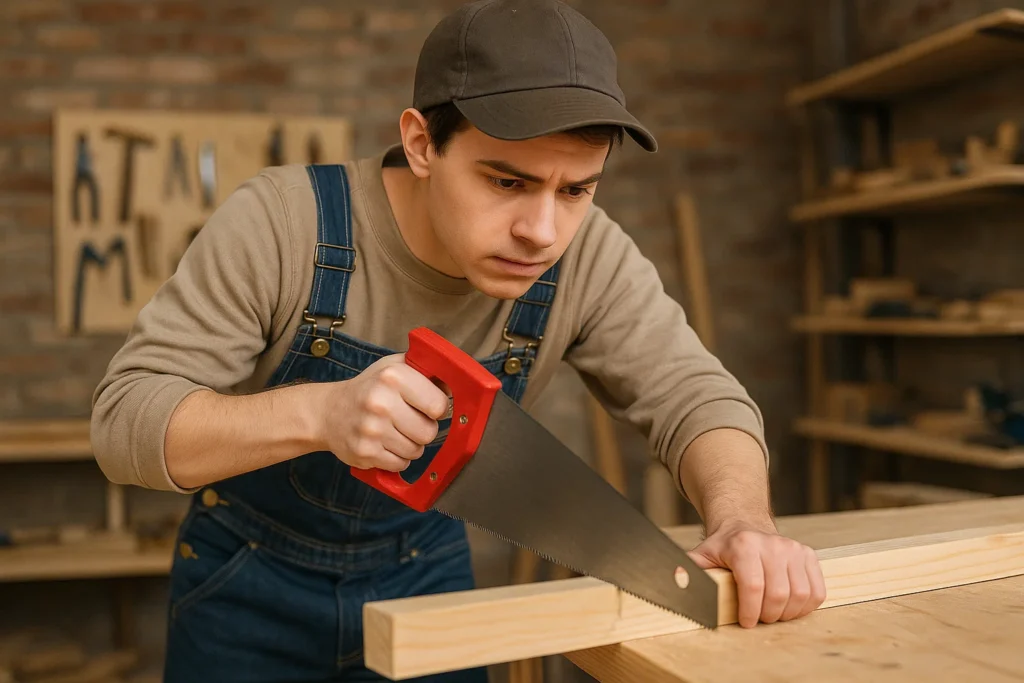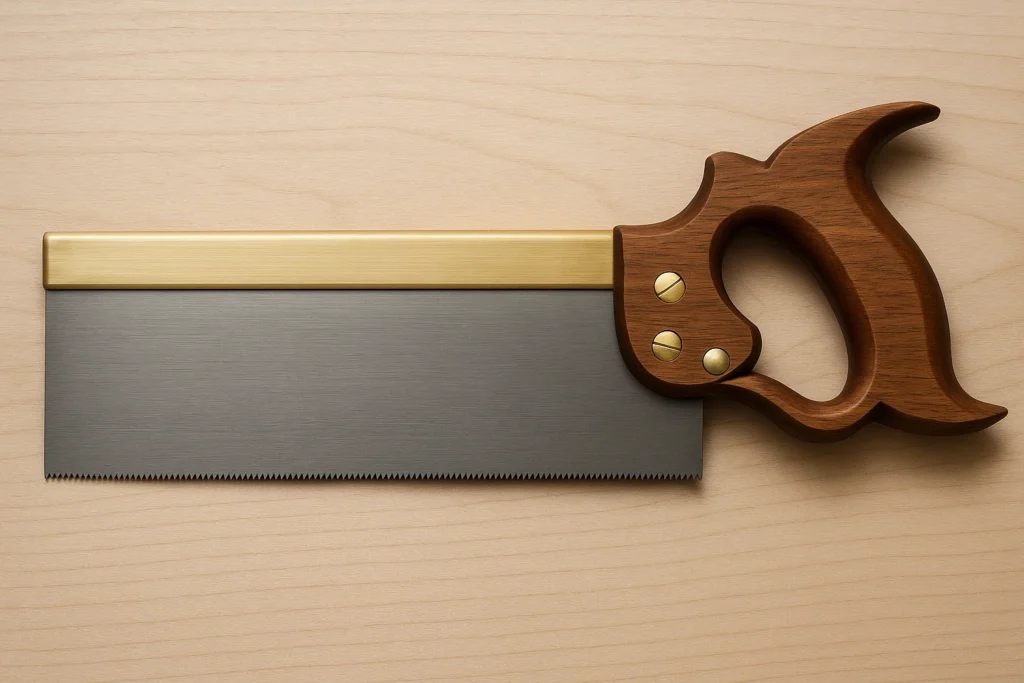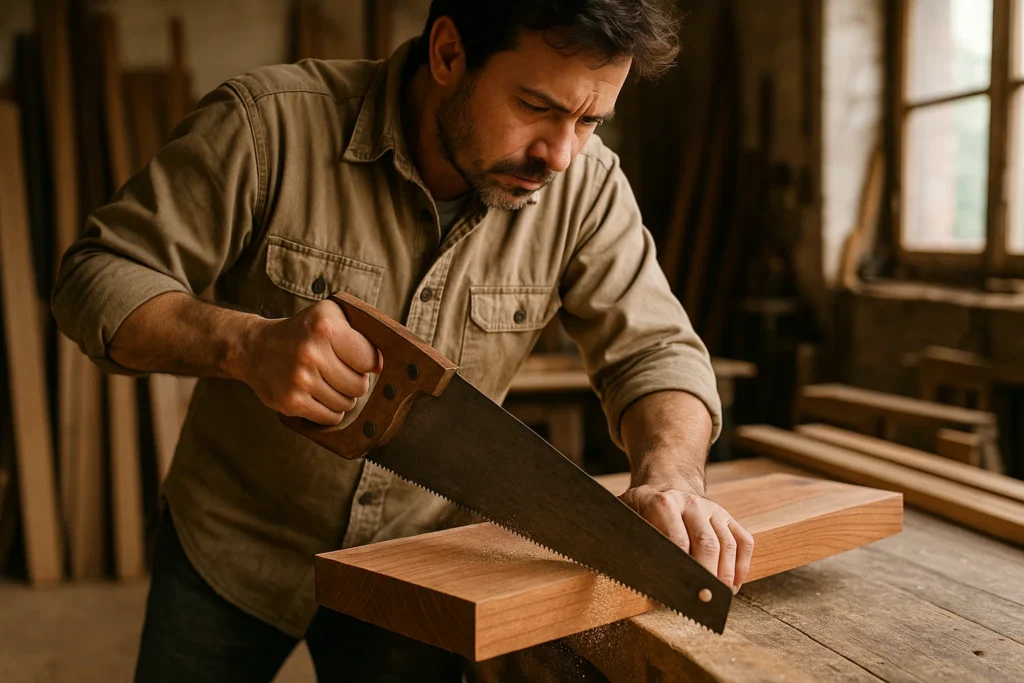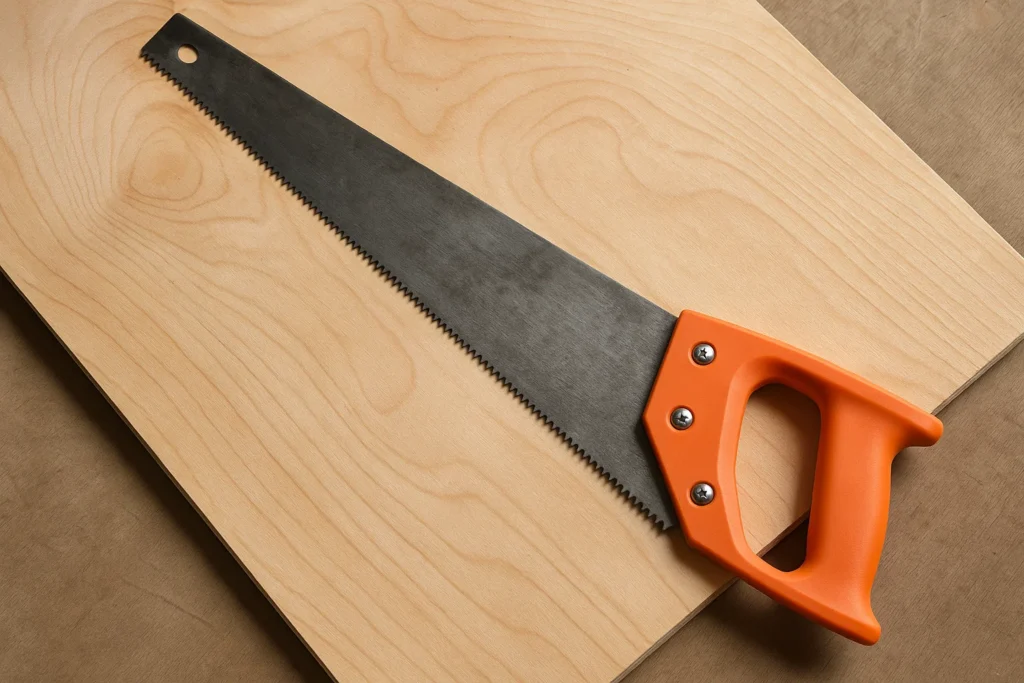The ZONA ZON35‑550 razor saw offers razor‑sharp, 42 TPI precision and a .010″ kerf for clean cuts in wood, plastic, soft metal, and carbon fiber. Its lightweight design ensures control, though the blade may bind and require replacement under heavy use.
Model Making Can Be Harder Than It Looks
Choosing the right hand saw for model making can be harder than it looks.
With so many types available, each with different blades, tooth counts, and cutting styles; it’s easy to end up with the wrong tool.
A poor match can lead to rough cuts, broken parts, or wasted materials. This guide breaks down the best hand saws for model work and helps you pick the right one based on your needs.
Key Takeaways
- ZONA Razor Saw is our top pick for clean, controlled model cuts.
- The wrong saw can damage your model or waste material.
- Razor saws are best for clean, precise cuts in softwoods and plastics.
- Jeweler’s saws are ideal for tiny curves and interior cuts.
- Japanese pull saws give smooth, accurate cuts with less effort.
- Tooth count (TPI) affects cut quality—more teeth mean cleaner cuts.
- Blade type, thickness, and flexibility all impact control and precision.
- Choose the saw based on your material, cut type, and scale.
- Secure your work and cut slowly to avoid mistakes.
- Beginners should start with a fine-tooth razor saw and expand from there.
Some Images are generated by AI for illustration.
Best Hand Saws For Model Making
Hand Saw | Details | Blade Length | TPI |
|---|---|---|---|
6‑1/2 in (16.5 cm) | 42 TPI | ||
6 in (15.2 cm) | 46 TPI | ||
1.8 in (46 mm), 1.7 in (43 mm) | N/A | ||
4.5 in (11.4 cm) | 40 TPI | ||
2.28 in (5.8cm) -> 3 in (7.62cm) | Can Vary |
Note: We don’t test products ourselves. Instead, we go through user reviews and/or community discussions to find and recommend the best options.
1. ZONA Razor Saw
The ZONA ZON35‑550 razor saw offers razor‑sharp, 42 TPI precision and a .010″ kerf for clean cuts in wood, plastic, soft metal, and carbon fiber. Its lightweight design ensures control, though the blade may bind and require replacement under heavy use.
Key Features
- Blade Length: 6‑1/2 in (16.5 cm)
- TPI: 42 teeth per inch
- Blade Material: High Speed Steel
- Handle Type and Material: Straight wooden handle
- Saw Type: Fine Razor Saw
- Weight: 1.0 lb (0.45 kg)
Pros & Cons
Pros:
- Sharpness: Razor‑sharp teeth deliver clean, precise cuts on balsa, basswood, and hardwood with minimal effort and smooth edges.
- Thin Kerf: .010″ blade thickness creates a fine kerf for minimal material waste and perfect fit in guides or slots.
- Control: Sturdy blade‑to‑handle connection and thin profile make it easy to steer straight lines for model parts.
- Versatility: Cuts wood, plastic, brass, copper, and carbon‑fiber shafts without tearing or splintering fibers.
- Lightweight: At just 1 lb, it’s easy to maneuver and reduces hand fatigue during detailed hobby work.
Cons:
- Binding: Very fine teeth and slight set can catch or bind, slowing cuts and requiring careful, patient strokes.
- Durability: Blade dulls after limited cuts, often needing replacement rather than sharpening for sustained use.
- Handle Security: Some saws arrive with loose or poorly fitted handles that detach under use and need DIY fixes.
- Warping: Occasional bent or not‑perfectly‑straight blades out of the package compromise cut accuracy.
- Packaging: Soft envelope shipping often leads to delivery damage, including bent blades on arrival.
Note: These pros and cons are based on user review trends and latent consensus.
Our Verdict
Precision cuts for detailed model work.
Buy If:
- You need razor‑sharp teeth for clean, accurate hobby cuts.
- You’re working with thin materials and want minimal waste.
- You cut multiple materials—wood, plastic, soft metal, or carbon fiber.
- You prefer a lightweight saw that’s easy to steer.
Don’t Buy If:
- You require nonstop heavy‑duty cutting—blade dulls after limited use.
- You can’t tolerate occasional binding from very fine teeth.
- You need a perfectly straight blade out of the package.
- You want a saw you can resharpen rather than replace.
Overall, the ZONA razor saw delivers pinpoint accuracy and a fine kerf ideal for model‑making and delicate craftwork. Its light weight and versatility shine for precision tasks, but frequent replacement and careful handling may be needed for high‑volume use.
2. Excel Blade Set
Compact 6 in mitre box set with a sharp carbon steel blade for precise hobby cuts. Lightweight and versatile but blade life and handle strength may limit heavy use.
Key Features
- Blade Length: 6 in (15.2 cm), ideal for precise cuts in tight spaces
- TPI: 46 teeth per inch for clean, smooth cuts on fine materials
- Blade Material: Carbon steel blade for durability and consistent performance
- Handle Type and Material: K5 Knife handle
- Saw Type: Razor pull saw for controlled, accurate cutting
- Weight: 5.6 oz (159 g), lightweight for easy handling
Pros & Cons
Pros:
- Blade Sharpness: High-tooth-count blade delivers smooth, precise cuts for tiny model parts.
- Compact Form: Small footprint fits tight workspaces, ideal for detailed miniature work.
- Material Versatility: Capable of cleanly cutting wood, plastic, and soft metal without chipping.
- Lightweight: At just 5.6 oz (159 g), it reduces hand fatigue during extended crafting.
- Box Stability: Rigid aluminum mitre box holds shape well once clamped in place.
- Value: Affordable USA-made set offers strong performance per dollar.
- Cutting Speed: Pull saw design can cut plastic and resin up to 80 percent faster.
Cons:
- Blade Durability: Blade bends or dulls quickly under pressure, limiting its usable life.
- Handle Comfort: Hollow plastic handle feels flimsy and may loosen with repeated use.
- Size Limitation: 1.6 in (4 cm) interior width restricts cutting wider pieces.
- Box Softness: Aluminum walls can nick or develop shavings if saw slips off material.
- Securing Required: Lacks pre-drilled mounting holes, so clamps are needed for stability.
- Angle Drift: Some users report cuts wandering or edges chipping after multiple uses.
Note: These pros and cons are based on user review trends and latent consensus.
Our Verdict
A solid precision tool for light, detailed work.
Buy If:
- You need smooth, precise cuts on tiny model parts.
- You work in tight spaces where a compact saw fits.
- You cut wood, plastic, or soft metals without chipping.
- You want a lightweight tool to minimize hand fatigue.
Don’t Buy If:
- You require long-lasting blade performance for heavy cuts.
- You prefer a sturdy handle for extended, hard use.
- You cut materials wider than 1.6 in (4 cm).
- You need a miter box that mounts without extra clamps.
This saw excels at fine-detail crafting and offers great value for hobbyists. Its limited blade durability and handle comfort make it less suited for heavy or wide cutting tasks.
3. Tamiya Fine Craft
A compact handsaw with fine, switchable blades for clean cuts in plastic, resin, and wood. Ideal for detailed model work but less suited for heavy‑duty or humid environments.
Key Features
- Blade Length: 1.8 in (46 mm) wide blade, 1.7 in (43 mm) narrow blade
- TPI: [Missing data]
- Blade Material: Carbon tool steel SK95
- Handle Type and Material: Pencil style handle
- Saw Type: Fine craft handsaw
- Weight: 1 oz (30g)
Pros & Cons
Pros:
- Blade Options: Two blade sizes let you switch between sturdy cuts on thick parts and precise work in tight spots.
- Precision: Fine teeth deliver clean edges on plastic and resin with minimal effort.
- Compact: Small form factor slips into narrow areas for detailed model work.
- Versatile: Handles plastic, resin, wood, and styrene effectively for diverse hobby tasks.
- Pull Stroke: Pull‑only action reduces user fatigue and boosts cutting control.
- Sharpness: Blades stay sharp through many cuts, cutting down on replacements.
Cons:
- Slippage: Blades often loosen or pop out under tension, risking uneven cuts and safety.
- Fragile Blades: Thin blades bend or deform on anything harder than soft materials.
- Slow Cuts: Progress can feel sluggish on longer or wider cuts, adding to work time.
- Rust Prone: Carbon steel blades corrode in humid environments without extra care.
- Handle Quality: Plastic handle and chuck can feel cheap and may crack or loosen.
Note: These pros and cons are based on user review trends and latent consensus.
Our Verdict
A solid choice for precision model work.
Buy If:
- You need clean, precise cuts on plastic and resin.
- You work in tight spaces needing a small saw.
- You value switching between two blade sizes.
- You prefer a pull‑only cutting action.
Don’t Buy If:
- You require heavy‑duty cutting on hard materials.
- You want a blade that never loosens under tension.
- You need fast progress on longer or wider cuts.
- You work in humid conditions without proper maintenance.
This saw excels at detailed hobby and model tasks, offering fine, durable blades and a compact pull‑stroke design. However, its thin blades and loose plastic handle limit performance on tougher cuts and in damp environments.
4. SMB Hobby Saw
A razor‑sharp, budget‑friendly hobby saw that excels on balsa, plastics, and light metals—but with a lightweight frame that may require frequent retightening for tougher cuts.
Key Features
- Blade Length: 4.5 in (11.4 cm)
- TPI: 40 teeth per inch (medium to coarse cuts)
- Blade Material: Carbon steel
- Handle Type and Material: Non‑retractable #5 heavy‑duty plastic handle
- Saw Type: Pull razor hobby saw
- Weight: 2.39 oz (68 g)
Pros & Cons
Pros:
- Sharpness: Blades remain razor‑sharp through multiple cuts, delivering precise, snag‑free results without frequent replacements.
- Versatility: Handles balsa, basswood, plastic, nylon and even soft non‑ferrous metals, making it a one‑tool solution for varied modeling tasks.
- Clean Cuts: Fine, laser‑cut teeth produce smooth edges in delicate materials like balsa without crushing fibers or causing tear‑out.
- Value: Matches the performance of pricier hobby saws at a budget price, stretching your modeling dollars further.
- Compatibility: Fits standard X‑Acto, Excel, Huron and Hobbico handles, so you can use your existing hobby‑knife hardware.
- Lightweight: At just 2.39 oz (68 g), it minimizes hand fatigue during long cutting sessions.
Cons:
- Handle Grip: Tends to loosen or slip under tension, requiring frequent retightening and interrupting workflow.
- Frame Flimsiness: Thin, soft metal spines can bend or deform easily, compromising blade stability and durability.
- Cut Direction: Blades often cut on a push stroke rather than pull, which may conflict with expected pull‑saw technique.
- Hardwood Limitation: Struggles with harder woods—users report bent blades and choppy cuts when forced beyond soft materials.
- Blade Height: Short blade depth limits use in miter boxes and deeper cuts.
Note: These pros and cons are based on user review trends and latent consensus.
Our Verdict
Reliable precision for small-scale cuts.
Buy If:
- You need razor‑sharp blades for clean cuts in balsa and plastics.
- You work with varied materials—wood, plastic, nylon, soft metals.
- You want a budget‑friendly alternative to premium hobby saws.
- You already own X‑Acto‑style handles and value compatibility.
- You prefer a lightweight tool to minimize hand fatigue.
Don’t Buy If:
- You require heavy‑duty cutting in hardwoods.
- You rely strictly on pull‑stroke technique rather than push cuts.
- You dislike stopping to retighten a slipping handle.
- You need deep cuts or miter‑box use due to limited blade depth.
This saw delivers sharp, versatile performance for fine modeling work at a great price. Tradespeople tackling tougher hardwoods or demanding a rock‑solid grip should consider a more robust alternative.
5. TOOLAN Model Craft
Compact, ergonomic quick‑change handle with versatile fine blades and files for precise model crafting; lightweight blades excel at delicate cuts but may flex under heavier use.
Key Features
- Blade Length: Ranges from 2.28 in (5.8cm) to 3 in (7.62cm)
- TPI: Can vary depending on the blade (Usually High)
- Blade Material: Stainless steel & high‑speed steel (durable, wear‑resistant blades)
- Handle Type and Material: Ergonomic rubber‑wrapped TPR handle (non‑slip comfort for extended use)
- Saw Type: Manual model craft hand saw (precision cutting for scale modeling)
- Weight: [Missing data]
Pros & Cons
Pros:
- Handle Comfort: Ergonomic rubber‑wrapped TPR grip reduces hand fatigue and stays secure during detailed cuts.
- Blade Swap: Spring‑loaded quick‑change mechanism lets you swap blades and files in seconds without tools.
- Versatility: Supports multiple fine saw blades and needle files for wood, plastic, and metal modeling tasks.
- Clean Cuts: Fine‑tooth blades deliver precise, burr‑free edges ideal for scale model detailing.
- Compact Size: Slim profile and small footprint allow access into tight or intricate work areas.
Cons:
- Blade Flimsiness: Ultra‑thin blades wobble under pressure and may bend when cutting tougher materials.
- Durability: Blades dull or break quickly with repeated use, necessitating frequent replacements.
- Cutting Limits: Struggles with harder plastics or thicker wood, making some model materials difficult to saw.
Note: These pros and cons are based on user review trends and latent consensus.
Our Verdict
Perfect for precise, lightweight model-making tasks.
Buy If:
- You value an ergonomic, rubber‑wrapped handle for extended use.
- You need rapid blade and file swaps without extra tools.
- You work on varied materials—wood, plastic, and soft metal.
- You require burr‑free, clean edges for detailed scale models.
Don’t Buy If:
- You plan to cut hard plastics or thick wood regularly.
- You need heavy‑duty blades that withstand high pressure.
- You expect prolonged blade life without frequent replacements.
- You require a tool for heavy or structural woodworking.
This saw shines in light‑duty, detail‑oriented crafting, offering comfort and versatility. However, its ultra‑thin blades limit performance on tougher materials, making it best suited for hobbyists and fine model work rather than heavy construction.
Types of Hand Saws for Model Making
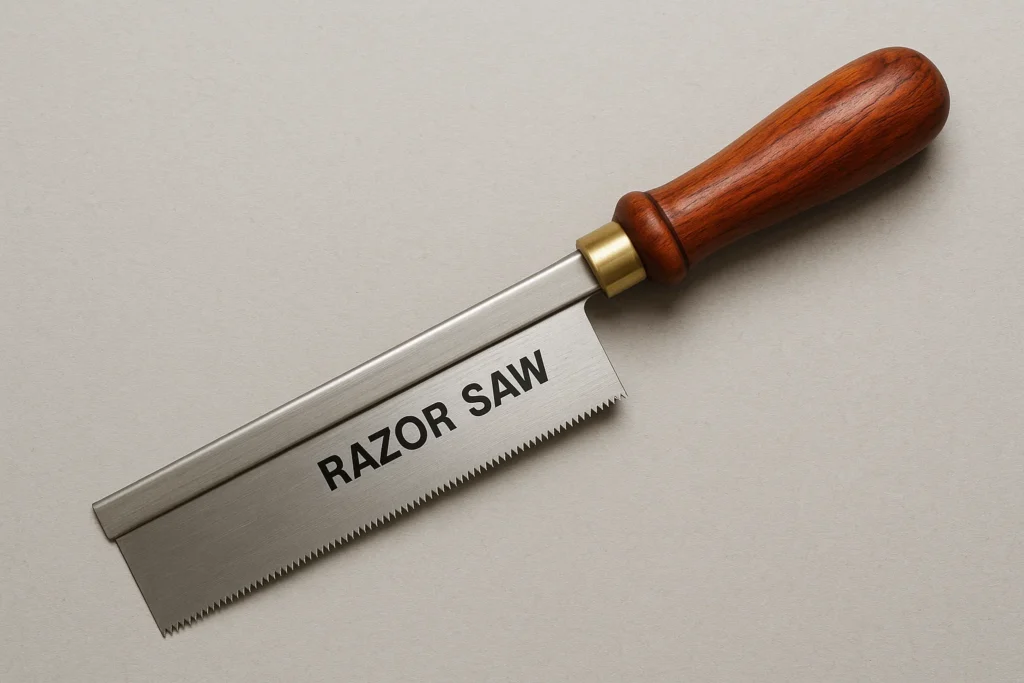
Model making requires saws that are precise, easy to control, and designed for small, delicate cuts. Not all hand saws meet these needs. Below are the main types used in model woodworking, each with a specific role.
1. Razor Saw
- Best for: Thin, clean cuts in soft woods like balsa and basswood.
- Blade: Very thin and stiff, with fine teeth (usually 30+ TPI).
- Handle: Straight or pistol grip.
- Why use it?
Razor saws make accurate cuts without crushing or splintering soft material. The blade is usually backed (reinforced) to keep it from flexing, so your cuts stay straight. They’re ideal for slicing through sheet stock, small sticks, and dowels.
2. Dovetail Saw (Back Saw)
- Best for: Cutting hardwood parts and making joints like tenons or lap joints.
- Blade: Stiff-backed, thicker than a razor saw, with teeth around 15–20 TPI.
- Why use it?
It’s more aggressive than a razor saw, so it can handle harder woods. The spine keeps it from bending, giving you control when cutting deep into thicker stock. Great when building structural parts of models.
3. Jeweler’s Saw / Fret Saw
- Best for: Intricate shapes, curves, and internal cutouts.
- Blade: Ultra-fine and replaceable. Held in tension on a metal frame.
- Why use it?
Unlike other saws, this one doesn’t just cut straight lines. It can follow complex patterns. You can also thread the blade through a drilled hole to cut from the inside out—useful for windows or decorative cutouts.
4. Japanese Pull Saw (Dozuki)
- Best for: Ultra-precise straight cuts in hardwood or softwood.
- Blade: Thin and sharp, cuts on the pull stroke (not push).
- Why use it?
Pulling instead of pushing keeps the blade straight and reduces effort. It’s useful for tight-fitting parts where accuracy matters. The Dozuki style has a back spine like a dovetail saw but with much finer teeth.
Summary Table
Saw Type | Best For | Key Strength | Notes |
|---|---|---|---|
Razor Saw | Thin softwood cuts | Very fine teeth, stiff blade | Ideal starter tool |
Dovetail Saw | Joints, hardwood parts | Stronger, deeper cuts | Needs steady hand |
Jeweler’s/Fret | Curves and cutouts | Flexible, detailed blade work | Blades can snap, replaceable |
Japanese Pull | Clean precision cuts | Smooth, low-effort cuts | Requires gentle technique |
Key Features to Look For in Model Making Hand Saws
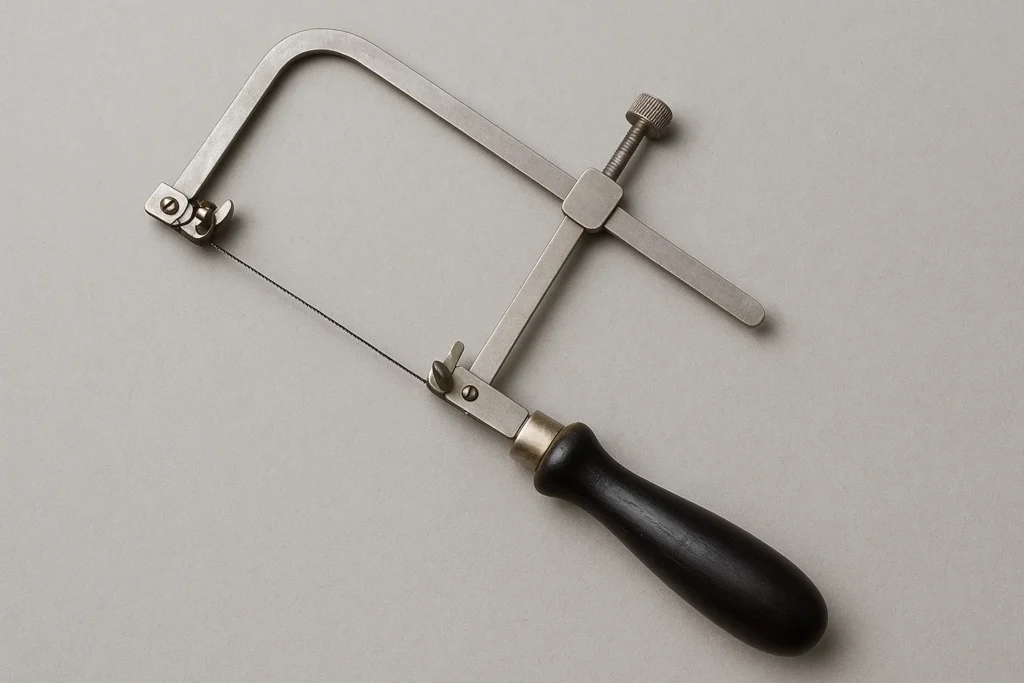
Not all fine-looking saws are good for model making. Some may look sharp or feel solid, but if the blade is too thick or the teeth too coarse, your cuts will be rough or imprecise.
These are not just technical specs—they directly affect how clean, accurate, and easy your cuts will be.
1. Blade Thickness
- Why it matters: Thinner blades remove less material (called kerf), so your parts fit better.
- A thick blade can split or crush small wood pieces.
- Ideal: Razor saws and Japanese pull saws usually have very thin blades (around 0.2 to 0.5 mm). For model work, thinner is better—as long as the blade stays rigid.
2. Teeth Per Inch (TPI)
- TPI = how fine the cut is.
- Higher TPI means smaller teeth, which make smoother, more controlled cuts with less tear-out.
- Model making sweet spot:
- 20–30 TPI for most hobby saws.
- Jeweler’s saws may go even higher.
- Avoid saws with TPI under 15 unless you’re cutting very thick hardwood.
3. Tooth Shape
- Crosscut teeth are designed to cut across the grain.
- Rip teeth cut along the grain.
- Some saws have a hybrid or universal tooth pattern.
- For model work: Crosscut or fine universal teeth work best since most cuts go across small parts.
4. Backed vs. Flexible Blades
- Backed blades (like dovetail or razor saws) have a steel spine for rigidity. They cut straight but can’t cut deeper than the height of the blade under the spine.
- Flexible blades (like fret or jeweler’s saws) allow more freedom for curves or tight internal cuts.
- Choose based on the type of cuts you need.
5. Blade Material & Replaceability
- Carbon steel or hardened steel blades stay sharp longer but can’t always be sharpened.
- Disposable blades (on jeweler’s and some razor saws) are easy to replace but can snap if misused.
- Pick a saw with replaceable blades if you plan to cut a lot or use hard materials.
6. Handle Comfort
- A good handle gives you control and reduces hand fatigue.
- Look for:
- Non-slip grip
- Size that fits your hand (especially for jeweler’s saws)
- Light weight for better accuracy
How to Choose the Right Saw for Your Project
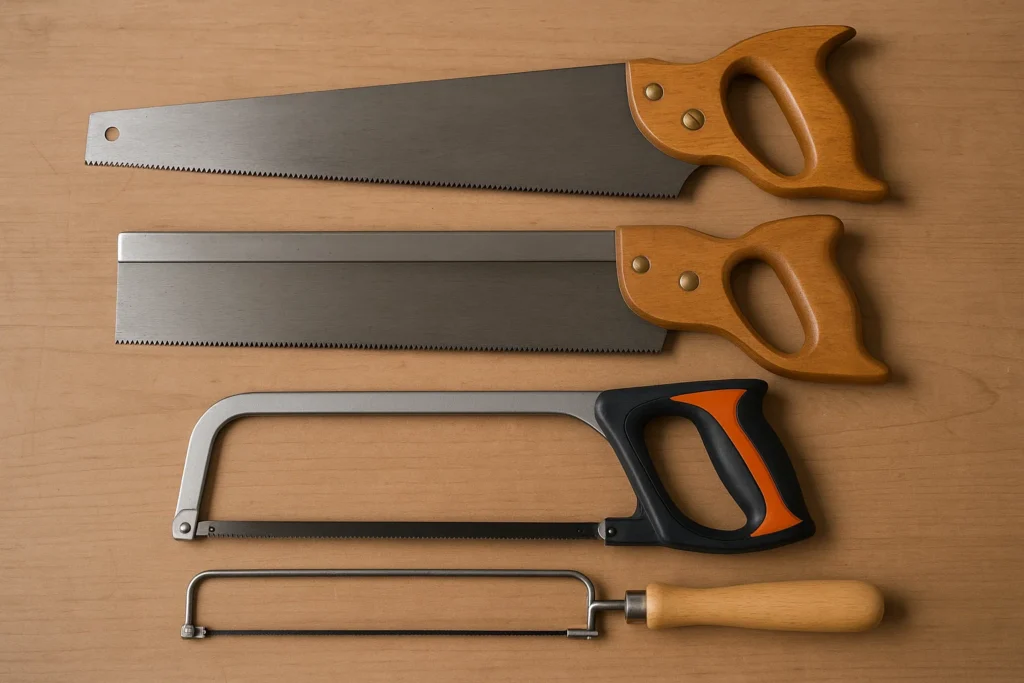
There’s no “one best” hand saw for model making. The right tool depends on what you’re building, the material you’re cutting, and the type of cuts you need. Below is a simple way to match the saw to your project, so you’re not left guessing or buying tools you won’t use.
1. Start with the Material
Ask: What kind of wood am I cutting?
- Softwoods like balsa, basswood, or pine
Use a razor saw. It cuts cleanly without crushing.
Great for walls, trim, and other small pieces. - Hardwoods like walnut, cherry, or maple
Use a dovetail saw or Japanese pull saw. These handle tougher wood without binding or chipping.
2. Match the Cut Type
Ask: Am I making straight cuts, joints, or shapes?
- Straight cuts (like trimming a piece to size)
Razor saw or pull saw - Joinery (like lap joints or half joints)
Dovetail saw — gives depth and strength - Curves, windows, or interior cutouts
Jeweler’s saw or fret saw — you can remove wood from the inside without touching the edges
3. Consider Project Scale
Ask: How detailed is the model?
- Miniature buildings, dollhouses, railroads
Razor saws and pull saws are ideal for framing and fitting. - Ship models, architectural mockups, fine art pieces
Add a jeweler’s saw for complex or tiny detailing. - General hobby use or mixed materials
Start with a razor saw, then add others as your needs grow.
Pro Tip: If you’re not sure, start with a razor saw. It’s the most versatile and safest choice for most beginners. Then, expand based on the kinds of cuts your projects demand.
Safety Tips for Small-Scale Sawing

Model making may seem low-risk, but even small saws can cause injury or damage your work if not used properly.
Safety here isn’t just about protecting your hands — it’s also about staying in control, avoiding mistakes, and keeping your materials from slipping or snapping.
1. Use a Stable Work Surface
- Always cut on a solid, flat surface.
- Use a cutting mat, bench hook, or mini vise to hold your parts in place.
- Never try to hold a small piece in your hand while sawing — it’s unsafe and leads to crooked cuts.
2. Protect Your Eyes
- Even with tiny blades, wood chips can fly—especially when cutting hardwood.
- Wear safety glasses to prevent eye injury.
3. Watch Your Hands and Grip
- Keep your fingers away from the cutting path.
- Don’t force the saw. If it binds, stop and reposition.
- Use slow, steady strokes to stay in control.
4. Choose the Right Tool
- Using a saw too big or aggressive for the task increases the chance of slipping.
- Stick with fine-tooth saws that match the material and cut style.
If your hands get tired or your cuts start drifting, stop. Fatigue leads to mistakes. Model work rewards patience and focus.
Final Thoughts
The best hand saw for model making depends on your project’s needs.
Razor saws offer clean, precise cuts for soft materials, while dovetail and pull saws handle hardwoods. Jeweler’s saws are ideal for curves and details.
Choose based on material, cut type, and scale. For most beginners, a fine-tooth razor saw is a solid place to start.
As your skills grow, adding more specialized saws will help you tackle more complex builds with confidence.
The ZONA ZON35‑550 razor saw offers razor‑sharp, 42 TPI precision and a .010″ kerf for clean cuts in wood, plastic, soft metal, and carbon fiber. Its lightweight design ensures control, though the blade may bind and require replacement under heavy use.
If you see any kind of mistake in our content, make sure to reach out to us.
Frequently Asked Questions (FAQs)
How do I choose the right hand saw?
Choose based on what you’re cutting and the type of cuts you need.
- Material: Use fine-tooth saws (like razor or pull saws) for softwoods and detailed cuts; use dovetail or Japanese saws for hardwoods.
- Cut type: Straight cuts need stiff-blade saws; curves or interior shapes need flexible-blade saws like a jeweler’s or coping saw.
- Project size: Smaller models need precise, lightweight tools. Always match the saw’s tooth count (TPI) and blade size to your task.
What is a kataba saw?
A kataba saw is a Japanese pull saw with no back spine. It cuts on the pull stroke, allowing deep, straight cuts in wood.
Its thin, sharp blade offers clean results with little effort. Unlike a dozuki (which has a spine), the kataba can cut deeper and through thicker material.
What is a hobby saw?
A hobby saw is a small, fine-tooth hand saw used for crafts, models, or precision work. It’s designed for cutting softwoods, plastic, and soft metals.
Hobby saws often have replaceable blades and lightweight handles, making them easy to control for delicate cuts.
What is the difference between a coping saw and a jeweler’s saw?
Coping saws have thicker blades and a deeper frame, better for larger curves in wood and plastic.
Jeweler’s saws use ultra-fine, replaceable blades, ideal for tiny curves, metal, or detailed cutouts.
Both can cut shapes, but the jeweler’s saw handles finer, more delicate work.
The Grain Bros was started to serve woodworkers who can’t find products for their specific use case. We found out that there are not many media outlets extensively covering this topic. That’s why, we are here, to do the research and find the perfect products for your next DIY project. So you don’t have to juggle your tools and laptop at the same time.
If you see any kind of mistake in our content, make sure to reach out to us.


